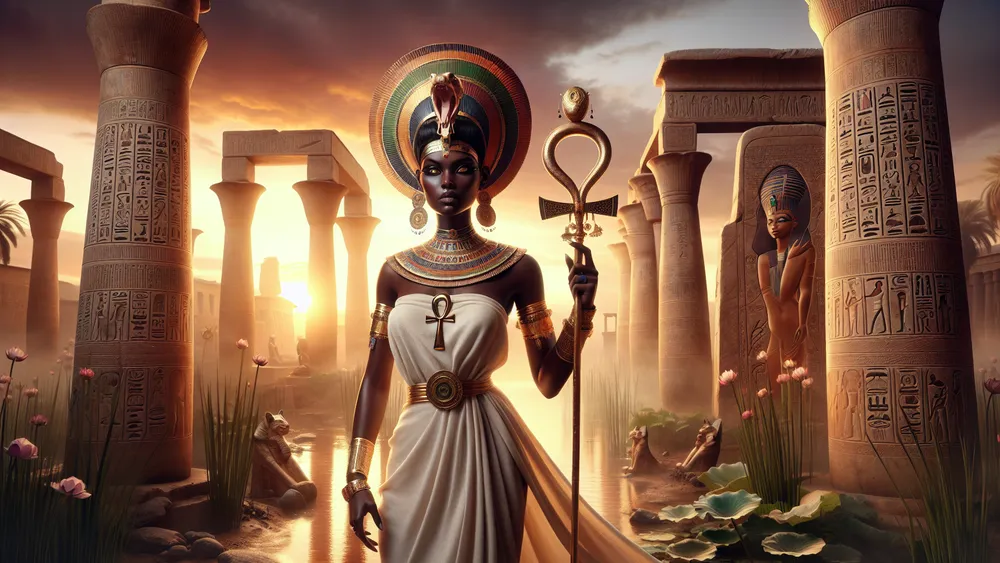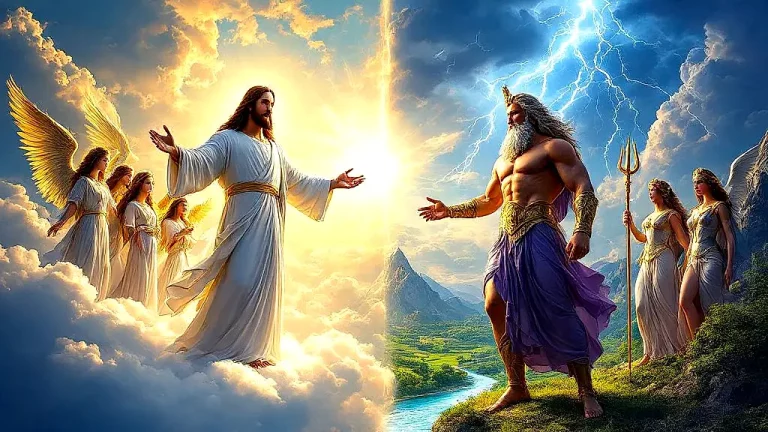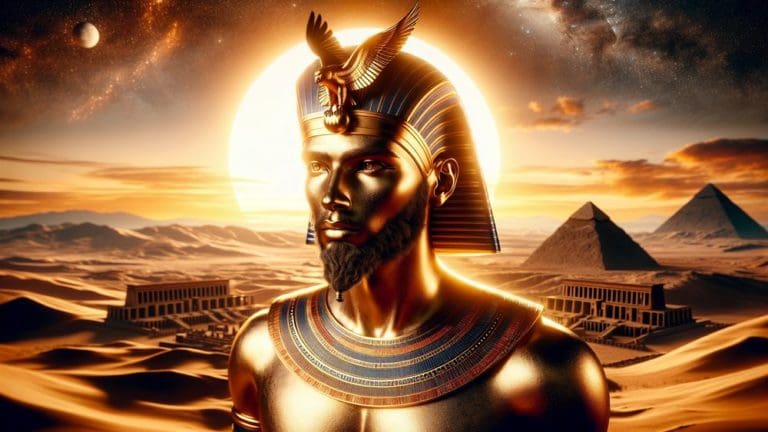Amunet: Ancient Egyptian Goddess Of Protection
Hello, we’re going to talk about Amunet, an old Egyptian goddess who guards people. In this article, we will dig into the interesting world of Egyptian myths. Mainly, we’ll talk about Amunet‘s beginnings, her part in the creation story, also her job as a protector. Think of Amunet being like a top protector, kind of like a modern security system that watches and protects.
Key Points:
- Amunet is an ancient Egyptian goddess of protection.
- She is linked with Amon-Ra and later replaced by the goddess Mut.
- Amunet is known for her role in the creation story as the Mother Who Is Father.
- Key symbols of Amunet include the feather, Red Crown of Lower Egypt, and staff.
- Amunet was worshipped during the Old and Middle Kingdoms in Egypt.
- Important temples for Amunet include the Karnak Temple Complex and Temple of Luxor.
- Amunet’s influence can be seen in today’s media and pagan practices.
Throughout this whole piece, you will learn about her symbols, her special tie with Amon-Ra, and how her worship changed over time. We will also see how Amunet is shown in old art and writings, and will even mention some archaeological finds that tell us more about her worship. In the end, we will check out how Amunet‘s influence is seen in today’s media and spirituality.
Whether you are just learning about Egyptian myths or want to know more, this complete guide will give you an in-depth and interesting look at Amunet, the goddess of protection.
Amunet: Overview and Key Facts
| Key Point | Description |
|---|---|
| Name | Amunet (also spelled like Amonet, Amentet, or Imentet) |
| Job | Goddess of Protection |
| Starting Place | Old Egyptian stories |
| Related Gods | Amon-Ra (her partner), then Mut (who later took her place) |
| Symbols | Feather, Red Crown of Lower Egypt, Staff |
| How she is shown in pictures | Often shown as a woman with a feather on her head or with the Red Crown |
| Place in First Story | She is called the “Mother Who Is Father,” important in first story |
| Time of Worship | Especially during the Old and Middle Kingdoms |
| Main Temples | Karnak Temple Complex, Thebes |
| Historical Change | Taken over by the goddess Mut later on |
| Modern Impact | Found in today’s shows and latest pagan beliefs |
Getting to Know Amunet
To really understand Amunet’s importance, we should look deeper at her beginnings, jobs, and the signs that show who she is.
Who Exactly is Amunet?
Amunet, also called Amentet or Imentet, is an essential character in old Egyptian stories, respected as a goddess of guarding. She comes from the early times of Egyptian history. Her importance is mainly because she is a guarding deity. Think of her as the top protector, like a watchful guardian who looks out for safety. Amunet is often linked with Amon-Ra, who is one of the key gods in the Egyptian group of gods, and later with the goddess Mut, who took over some of her worship roles. Here, let’s see some key things about Amunet:
- Beginnings: Amunet’s worship started in the Old and Middle Kingdoms of Egypt.
- Job: She is mainly known as a goddess of guarding, protecting both the living and the dead.
- Connections: Amunet is very close to Amon-Ra, her partner, and later to Mut, who took some of her jobs.
Understanding these points, you can see Amunet’s important part in the rich stories of Egyptian gods.
Amunet is a key Egyptian goddess known for guarding and protecting, closely linked with Amon-Ra and Mut.
Amunet and the Creation Story
In the detailed stories of Egyptian gods, Amunet has an important job in the creation story. She is called the “Mother Who Is Father,” a name that shows her special place in the group of gods. This name highlights her two jobs in the creation story where she has both mother and father parts, like a single parent who does both things in a family.
Amunet was there at the start of everything, working with other first gods to make the world. Her protective nature isn’t just about safeguarding people but also keeping the world itself safe, making sure the universe stays in order and doesn’t fall apart. By knowing Amunet’s role in the creation story, you can see her great importance in old Egyptian beliefs.
What Amunet’s Symbols Mean
Amunet is shown with many symbols that show her guarding nature and her godly power. One of the most important symbols linked with her is the feather, which she often has on her head. This feather is more than just a decoration; it stands for Ma’at, the ideas of truth, balance, and order in old Egyptian belief.
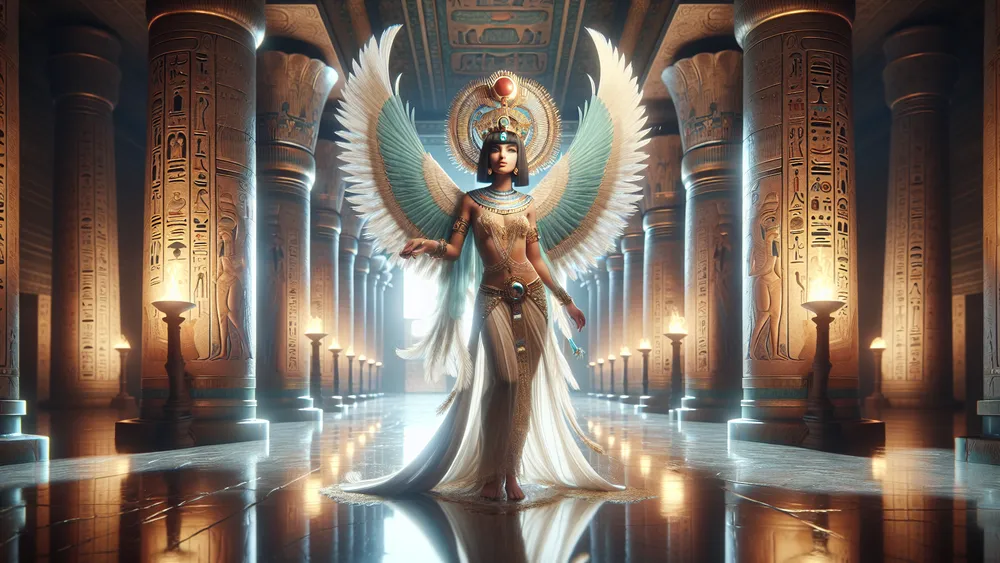
Because she wears the feather, Amunet shows these ideas, meaning her job in keeping the universe in harmony. Another big symbol is the Red Crown of Lower Egypt, which she sometimes wears. This crown shows her rule and guarding over the north part of Egypt, showing her place as a protecting goddess.
To get what these symbols mean better, here are some usual symbols linked with Amunet and what they stand for:
- Feather: Stands for Ma’at, the ideas of truth, balance, and order.
- Red Crown of Lower Egypt: Shows her guarding power over Lower Egypt.
- Staff: Often seen with a staff, showing her role as a protector and guide.
- Scepter: Means her power and godly rule.
By getting these symbols, you can see more about Amunet’s guarding parts and her importance in old Egyptian stories.
Amunet and Amon-Ra: Their Special Connection
Amunet and Amon-Ra are a strong godly pair in old Egyptian tales, each fitting together the other’s qualities and tasks. Amon-Ra, often seen as the king of the gods and the god of the sun, stands for the clear, active power of making and life. Different from that, Amunet shows the hidden, guarding parts of the gods, usually behind the scenes to keep things in order.
Think of their link as a balanced team, like a group where one does the big parts while the other gives key support from behind. Together, they show the two sides of life – seen and unseen, doing and not doing – making sure the universe stays steady and keeps going.
This matching way of working shows their importance in the Egyptian group of gods, highlighting how their joined power was needed for the well-being of both the gods and people.
When Amunet Was Replaced by Mut
The replacement of Amunet by the goddess Mut happened during a big time of change in old Egyptian history, especially around the New Kingdom times. This change was because Thebes became a major religious and political place, where Mut, the partner of Amon-Ra, gained importance. And you can see this switch like a change in leadership in a company, where a new leader brings different things and focuses.
Mut’s rise to be important was partly because she was linked with the powerful god Amon-Ra, and her job as a mother goddess matched well with the changing religious feelings of the time. So, the worship of Amunet slowly went down, and her temples and pictures were often reused or taken over by those for Mut.
And this shift changed not only the religious scene but also how Amunet was seen and honored, marking a big change in the Egyptian group of gods.
Amunet’s Role in Ancient Egypt
Now that we have looked at Amunet’s stories and her connections with other gods, let’s go into her importance in old Egyptian society.
Worshipping Amunet and Her Temples
Worship practices for Amunet were a big part of the daily lives of old Egyptians, who wanted her protection and help. They did rituals like giving food, drink, and incense, which they thought could calm the goddess and get her favor. Priests and priestesses were crucial in these ceremonies, being the go-betweens for Amunet and the people.

They did detailed rituals with prayers, songs, and incense burning, all to call on Amunet’s protecting qualities. You can see these rituals as like modern religious ceremonies where people give offerings and say prayers to get help and blessings. Several big temples and places were for Amunet, showing her importance in old Egyptian religion.
These temples were places of worship and community gatherings, where people came together to honor the goddess. Important temples include the Karnak Temple Complex, where Amunet was with Amon-Ra, and the Temple of Luxor, which also had places for her. These temples were not only amazing buildings but also held great historical value, being key spots for religious and cultural events.
Here are some important temples for Amunet and their historical value:
- Karnak Temple Complex: One of the largest religious sites in the world, where Amunet was with Amon-Ra.
- Temple of Luxor: Had places for Amunet, showing her importance in the Theban triad.
- Medinet Habu: Another big site for Amunet, showing her lasting influence in old Egyptian religion.
Worship practices for Amunet were a vital part of ancient Egyptian life, involving detailed rituals and offerings at temples like the Karnak and Luxor Temples.
Amunet in Egyptian Art and Writings
Amunet is often shown in old Egyptian art with specific pictures that highlight her protective ways and holy position. She is normally displayed as a woman who wears the Red Crown of Lower Egypt, which shows her link to the land and its people. In some pictures, she has a staff and an ankh, meaning life and power.
These art pieces were not just for looks but served as strong signs of her protective and caring nature. Imagine these pictures being like modern religious icons that tell specific traits and stories about the holy people they show. Besides visual art, Amunet is in different old Egyptian writings, including religious songs, prayers, and stories.
One notable example is the Pyramid Texts, where Amunet is called for her protective powers during the king’s trip to the afterlife. Another important text is the Coffin Texts, which also have prayers and spells that ask for Amunet’s protection. These writings give us useful ideas about how the old Egyptians saw Amunet and her part in their spiritual lives.
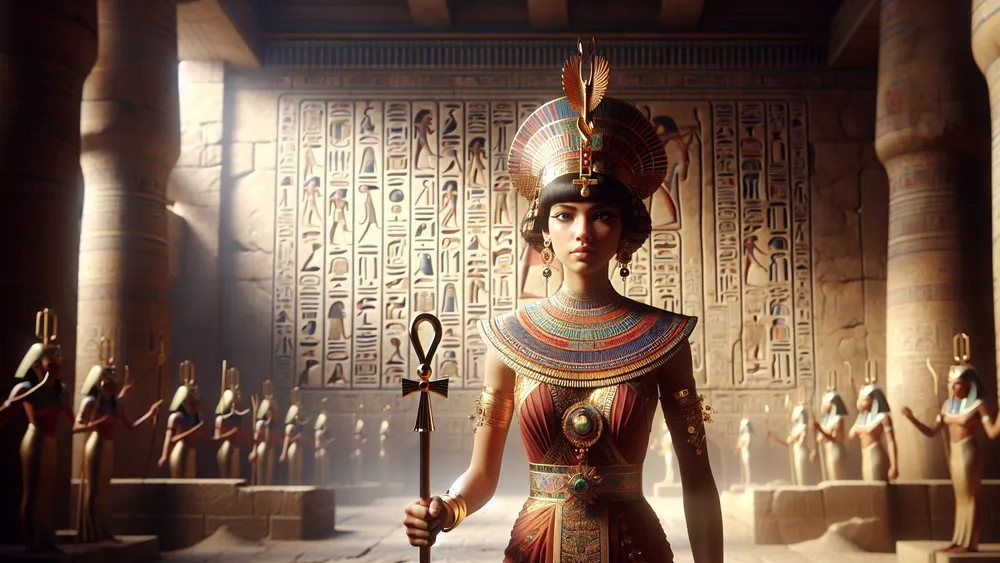
As modern religious books offer advice and comfort, these old writings helped people connect with their gods, making sure of their protection and favor.
Finding Amunet: Mummy Discoveries
Archaeological discoveries connected to Amunet have given interesting clues about her worship and importance in old Egyptian society. One of the most notable findings is the mummy of Amunet. It was discovered in the Deir el-Bahari cache, a hidden tomb that had the remains of many royal and high-status people.
So this discovery was like digging up a time capsule, showing us the burial practices and religious ideas of that time. The mummy of Amunet was decorated with amulets and writings asking for her protective powers, which showed her high status. These findings not only show the importance of Amunet in the Egyptian pantheon but also the detailed care taken in her burial practices.

The importance of these archaeological findings goes beyond the items themselves; they show more about how Amunet was worshipped and her role in the spiritual lives of the old Egyptians. For example, the presence of specific amulets and writings suggests that Amunet was asked for protection in the afterlife, which was very important in Egyptian religion.
These findings are like discovering old manuscripts that give new views on historical events, making our understanding of the past richer. The detailed study of these items has helped historians and archaeologists put together the cultural and religious context of Amunet’s worship, showing her lasting influence.
| Discovery Location | Description | Significance |
|---|---|---|
| Deir el-Bahari Cache | Mummy of Amunet | Shows burial practices and religious beliefs |
| Karnak Temple Complex | Inscriptions and Amulets | Highlights Amunet’s protective role |
| Luxor Temple | Statues and Reliefs | Shows her importance in the Theban triad |
Amunet’s Impact Today
After looking at Amunet’s importance in history and the things that were found, let’s now see how she still affects modern culture and spirituality.
Amunet in Movies, TV, and Books
Amunet has found her way into modern media. She is in many movies, TV shows, and books that use old Egyptian stories. For example, she was clearly in the 2017 movie “The Mummy,” where she was shown as a strong and angry figure.

This movie version, while made more exciting for fun, has put Amunet in front of people, making them interested in her old stories. And TV shows and novels also often use Amunet as a character. They mix historical facts with made-up stories. These shows and books greatly shape what people think, often showing her protective and mysterious parts.
Like how Greek gods in today’s culture shape our thoughts, showing Amunet in today’s media helps keep her story going. It brings her to new audiences and makes sure her story is still told.
Amunet in Modern Spirituality and Pagan Practices
In today’s paganism and spiritual ways, Amunet has a significant place as a goddess of protection and mystery. People today often call upon Amunet when they do rituals to use her protective powers. It is much like how you might ask a guardian figure in other beliefs.
For example, during ceremonies, they might use symbols tied to Amunet, like the ankh or the Red Crown, to make a sacred space and invite her in. These rituals can have offerings, chants, and meditations to connect with Amunet’s old wisdom and protective qualities.
Just as people today might light candles or say prayers to feel safe and guided, those who follow today’s pagan paths use Amunet in their spiritual practices to feel her protective embrace. This ongoing respect ensures Amunet’s story continues, linking the ancient past with today’s spiritual life.
Pantheon of Egyptian Mythology Gods
The pantheon of Egyptian mythology is a rich mix of gods. Each has their own unique traits, stories, and roles in the ancient Egyptian belief system. From well-known gods like Ra, the sun god, to lesser-known deities, the Egyptian pantheon shows the detail and depth of their spiritual world.
If you look into all these interesting gods, you can find a detailed list of all the Egyptian gods. This long list gives detailed information on each god and goddess. And it helps you understand better their importance and how they were honored in ancient times.
FAQs
1. Who were the primary worshippers of Amunet?
The primary worshippers of Amunet were the ancient Egyptians, particularly those in Thebes where she was venerated as a protective deity.
2. What are the key symbols associated with Amunet?
The key symbols associated with Amunet include the red crown of Lower Egypt, the staff, and the ankh, each representing her protective qualities and divine authority.
3. How did Amunet’s role change over time?
Amunet’s role changed over time as she was gradually replaced by the goddess Mut in the Egyptian pantheon.
4. Are there any modern-day festivals or rituals dedicated to Amunet?
Modern-day festivals or rituals dedicated to Amunet are rare, but some contemporary pagan groups incorporate her into their spiritual practices.

